Analytical Model for Thermoregulation of the Human Body in Contact with a Phase Change Material (PCM) Cooling Vest
Abstract
:1. Introduction
2. Materials and Methods
2.1. Hotplate
2.2. Sample Preparation
2.3. Procedure
3. Heat Transfer Theory
3.1. Basic Heat Equations
3.2. Human Cooling Model
Skin Temperature
3.3. Solutions for T1 and T3
3.3.1. Solution 1: Human Body Cooling with Heat Production and Radiation; No PCM Layer
3.3.2. Solution 2A: Human Body Cooling with PCM Layer, Heat Production and Radiation
3.3.3. Solution 2B: Human Body Cooling with PCM during Melting Stage
3.3.4. Solution 3A: Hot Plate with PCM Transients and Radiation
3.3.5. Solution 3B: Hot Plate during PCM Melting with Radiation at the PCM Surface
4. Model Verification
4.1. Comparison with Measured Cooling Power of PCM Ice Packs
4.2. Comparison with Data Reported in Literature
5. Parametric Study
6. Discussion, Limitations and Recommendations for Future Work
- The model considers one-dimensional planar heat transfer and thus neglects the effects of body curvature on the conduction and heat loss (or gain) to the environment. Since a curved body has more surface area per unit volume, this assumption underestimates the radiation contribution, and this effect gets larger for more curved body parts such as arms and legs. Since we are interested in the heat transfer near the PCM layer, the rule of thumb is that the model is valid if the PCM thickness is much less than that of (half of) the body, d3/d1 « 1. Note that in thermophysiology models the body is usually considered to consist of cylindrical elements [12,13,14]. This may be a good approximation for the arms and legs but could be less appropriate for the trunk area.
- In order to simulate human thermoregulation in realistic conditions, heat loss by sweat evaporation, respiration and the effect of subcutaneous blood flow must be taken into account. As mentioned before, all these effects essentially act as an energy source or loss contributions in the body core layer and thus only change the numerical value of the Q1 parameter in our model. The equations to model these energy loss terms are conveniently described in [33].
- In practice, only a part of the torso surface is covered with PCM packs. The effect of such a partial coverage on the core temperature can be estimated by a simple averaging process.
7. Conclusions
- A set of closed-form equations is presented which do not need a numerical solver and directly relate cooling vest design parameters such as the PCM mass and melting temperature to its performance
- The model was able to reproduce cooling power data obtained from experiments with ice packs on a hot plate with constant surface temperature as well as PCM cooling data in various literature sources;
- The relation between the PCM performance and the PCM melting temperature and layer thickness is shown in a dedicated parametric study.
Supplementary Materials
Author Contributions
Funding
Data Availability Statement
Conflicts of Interest
Nomenclature
| A | Surface area of layer element (m2) | ||
| A1, A2 | Parameters in solution for T (°C) | Greek symbols | |
| C | Parameter in Equations (14) and (15) (s−1) | α | Parameter in exponential function (s−1) |
| c1, c3 | Specific heat (J kg−1 K−1) | β | Parameter in Equations (13) and (15) (-) |
| d | Layer thickness (m); d1 is half the torso thickness | γ | Parameter in Equations (13) and (15) (-) |
| E | Energy (J) | δ | Parameter in Equations (13) and (15) (-) |
| f | Fraction (-) | ρ | Density (kg m−3) |
| hi | Parameter (s−1) | Sub- and superscripts | |
| hr | radiative heat transfer coefficient (Wm−2K−1) | 0 | Solution at t = 0 |
| H | Parameter (s−1) | 1 | Body core layer |
| k | Thermal conductivity (Wm−1K−1) | 2 | Insulation between body core and PCM layer |
| L | Latent heat of PCM (J/kg) | 3 | PCM layer |
| mi | Mass of layer i (kg) | 4 | Outside insulation |
| P | Cooling power (W) | a | ambient |
| q | Heat flux (W/m2) | eff | effective |
| Q | Heat production per unit area (W/m2) | HF | Heat flow |
| Q’ | Q/(ρcd) (K/s) | hp | hotplate |
| QV | Volumetric heat production (W/m3) | i | Layer number |
| R | Thermal resistance (m2K W−1) | l | liquid |
| t | Time (s) | m | melt |
| T | Temperature (°C) | R | Resistance contribution |
| x | Thickness coordinate (m) | rad | Radiation contribution |
| s | solid | ||
| Abbreviations | skin | Skin Layer | |
| PCM | Phase change material | ||
References
- Mokhtari Yazdi, M.; Sheikhzadeh, M. Personal cooling garments: A review. J. Text. Inst. 2014, 105, 1231–1250. [Google Scholar] [CrossRef]
- Smolander, J.; Kuklane, K.; Gavhed, D.; Nilsson, H.; Holmer, I. Effectiveness of a light-weight ice-vest for body cooling while wearing fire fighter’s protective clothing in the heat. Int. J. Occup. Saf. Ergon. JOSE 2004, 10, 111–117. [Google Scholar] [PubMed]
- Teunissen, L.P.J.; Wang, L.-C.; Chou, S.-N.; Huang, C.-H.; Jou, G.-T.; Daanen, H.A.M. Evaluation of two cooling systems under a firefighter coverall. Appl. Ergon. 2014, 45, 1433–1438. [Google Scholar] [CrossRef] [PubMed]
- Butts, C.L.; Smith, C.R.; Ganio, M.S.; McDermott, B.P. Physiological and perceptual effects of a cooling garment during simulated industrial work in the heat. Appl. Ergon. 2017, 59, 442–448. [Google Scholar]
- House, J.R.; Lunt, H.C.; Taylor, R.; Milligan, G.; Lyons, J.A.; House, C.M. The impact of a phase-change cooling vest on heat strain and the effect of different cooling pack melting temperatures. Eur. J. Appl. Physiol. 2013, 113, 1223–1231. [Google Scholar]
- Song, W.; Wang, F. The hybrid personal cooling system (PCS) could effectively reduce the heat strain while exercising in a hot and moderate humid environment. Ergonomics 2016, 59, 1009–1018. [Google Scholar]
- Ouahrani, D.; Itani, M.; Ghaddar, N.; Ghali, K.; Khater, B. Experimental study on using PCMs of different melting temperatures in one cooling vest to reduce its weight and improve comfort. Energy Build. 2017, 155, 533–545. [Google Scholar] [CrossRef]
- Li, W.; Liang, Y.; Liu, C.; Ji, Y.; Cheng, L. Study of ultra-light modular phase change cooling clothing based on dynamic human thermal comfort modeling. Build. Environ. 2022, 222, 109390. [Google Scholar] [CrossRef]
- ASTM F2371-10; Standard Test Method for Measuring the Heat Removal of Personal Cooling System Using a Sweating Heated Manikin. ASTM International: West Conshohocken, PA, USA, 2010.
- Ciuha, U.; Valenčič, T.; Mekjavic, I.B. Cooling efficiency of vests with different cooling concepts over 8-hour trials. Ergonomics 2021, 64, 625–639. [Google Scholar] [CrossRef]
- Gao, C.; Kuklane, K.; Holmér, I. Cooling vests with phase change material packs: The effects of temperature gradient, mass and covering area. Ergonomics 2010, 53, 716–723. [Google Scholar] [CrossRef]
- Gao, C.; Kuklane, K.; Holmér, I. Cooling vests with phase change materials: The effects of melting temperature on heat strain alleviation in an extremely hot environment. Eur. J. Appl. Physiol. 2011, 111, 1207–1216. [Google Scholar] [CrossRef] [PubMed]
- Stolwijk, J.A.J.; Hardy, J.D. Temperature regulation in man—A theoretical study. Pflüger’s Arch. Für Die Gesamte Physiol. Des Menschen Und Der Tiere 1966, 291, 129–162. [Google Scholar] [CrossRef]
- Fiala, D.; Lomas, K.J.; Stohrer, M. A computer model of human thermoregulation for a wide range of environmental conditions: The passive system. J. Appl. Physiol. 1999, 87, 1957–1972. [Google Scholar] [CrossRef] [PubMed]
- Tanabe, S.-I.; Kobayashi, K.; Nakano, J.; Ozeki, Y.; Konishi, M. Evaluation of thermal comfort using combined multi-node thermoregulation (65MN) and radiation models and computational fluid dynamics (CFD). Energy Build. 2002, 34, 637–646. [Google Scholar] [CrossRef]
- Potter, A.W.; Blanchard, L.A.; Friedl, K.E.; Cadarette, B.S.; Hoyt, R.W. Mathematical prediction of core body temperature from environment, activity, and clothing: The heat strain decision aid (HSDA). J. Therm. Biol. 2017, 64, 78–85. [Google Scholar] [CrossRef]
- Mokhtari Yazdi, M.; Sheikhzadeh, M.; Borhani, S. Modeling the heat transfer in a PCM cooling vest. J. Text. Inst. 2015, 106, 1003–1012. [Google Scholar] [CrossRef]
- Mokhtari Yazdi, M.; Sheikhzadeh, M.; Dabirzadeh, A.; Chavoshi, E. Modeling the efficiency and heat gain of a phase change material cooling vest: The effect of ambient temperature and outer isolation. J. Ind. Text. 2016, 46, 436–454. [Google Scholar] [CrossRef]
- Yazdi Motahareh, M.; Sheikhzadeh, M.; Chavoshi Seyed, E. Modeling the performance of a PCM cooling vest considering its side effects. Int. J. Cloth. Sci. Technol. 2015, 27, 573–586. [Google Scholar] [CrossRef]
- Hamdan, H.; Ghaddar, N.; Ouahrani, D.; Ghali, K.; Itani, M. PCM cooling vest for improving thermal comfort in hot environment. Int. J. Therm. Sci. 2016, 102, 154–167. [Google Scholar] [CrossRef]
- Itani, M.; Ghaddar, N.; Ghali, K.; Ouahrani, D.; Chakroun, W. Cooling vest with optimized PCM arrangement targeting torso sensitive areas that trigger comfort when cooled for improving human comfort in hot conditions. Energy Build. 2017, 139, 417–425. [Google Scholar] [CrossRef]
- Itani, M.; Ouahrani, D.; Ghaddar, N.; Ghali, K.; Chakroun, W. The effect of PCM placement on torso cooling vest for an active human in hot environment. Build. Environ. 2016, 107, 29–42. [Google Scholar] [CrossRef]
- Wan, X.F.; Wang, F.M.; Udayraj. Numerical analysis of cooling effect of hybrid cooling clothing incorporated with phase change material (PCM) packs and air ventilation fans. Int. J. Heat. Mass Tran. 2018, 126, 636–648. [Google Scholar] [CrossRef]
- Xu, P.; Kang, Z.; Wang, F.; Udayraj. A Numerical Analysis of the Cooling Performance of a Hybrid Personal Cooling System (HPCS): Effects of Ambient Temperature and Relative Humidity. Int. J. Environ. Res. Public Health 2020, 17, 4995. [Google Scholar] [CrossRef]
- Kang, Z.; Udayraj; Wan, X.; Wang, F. A new hybrid personal cooling system (HPCS) incorporating insulation pads for thermal comfort management: Experimental validation and parametric study. Build. Environ. 2018, 145, 276–289. [Google Scholar] [CrossRef]
- Wan, X.; Fan, J. A new method for measuring the thermal regulatory properties of phase change material (PCM) fabrics. Meas. Sci. Technol. 2009, 20, 025110. [Google Scholar] [CrossRef]
- Ying, B. Assessing the performance of textiles incorporating phase change materials. Polym. Test. 2004, 23, 541. [Google Scholar]
- Ghali, K.; Ghaddar, N.; Harathani, J.; Jones, B. Experimental and Numerical Investigation of the Effect of Phase Change Materials on Clothing During Periodic Ventilation. Text. Res. J. 2004, 74, 205–214. [Google Scholar] [CrossRef]
- Elson, J.; Eckels, S. An objective method for screening and selecting personal cooling systems based on cooling properties. Appl. Ergon. 2015, 48, 33–41. [Google Scholar] [CrossRef]
- Al-Mujahid, A.; Zedan, M.F. Transient heat-conduction response of a composite plane wall. Wärme-Und Stoffübertragung 1991, 26, 33–39. [Google Scholar] [CrossRef]
- Hu, Y.; Huang, D.; Qi, Z.; He, S.; Yang, H.; Zhang, H. Modeling thermal insulation of firefighting protective clothing embedded with phase change material. Heat Mass Transfer. 2013, 49, 567–573. [Google Scholar] [CrossRef]
- Carslaw, H.S.; Jaeger, J.C. Conduction of Heat in Solids; Oxford University Press: Oxford, UK, 1947. [Google Scholar]
- ASHRAE. Thermal Comfort Conditions; ASHRAE Standard: Peachtree Corners, GA, USA, 2005. [Google Scholar]
- Grabowski, A.; Farley, C.T.; Kram, R. Independent metabolic costs of supporting body weight and accelerating body mass during walking. J. Appl. Physiol. 2005, 98, 579–583. [Google Scholar] [CrossRef] [PubMed] [Green Version]
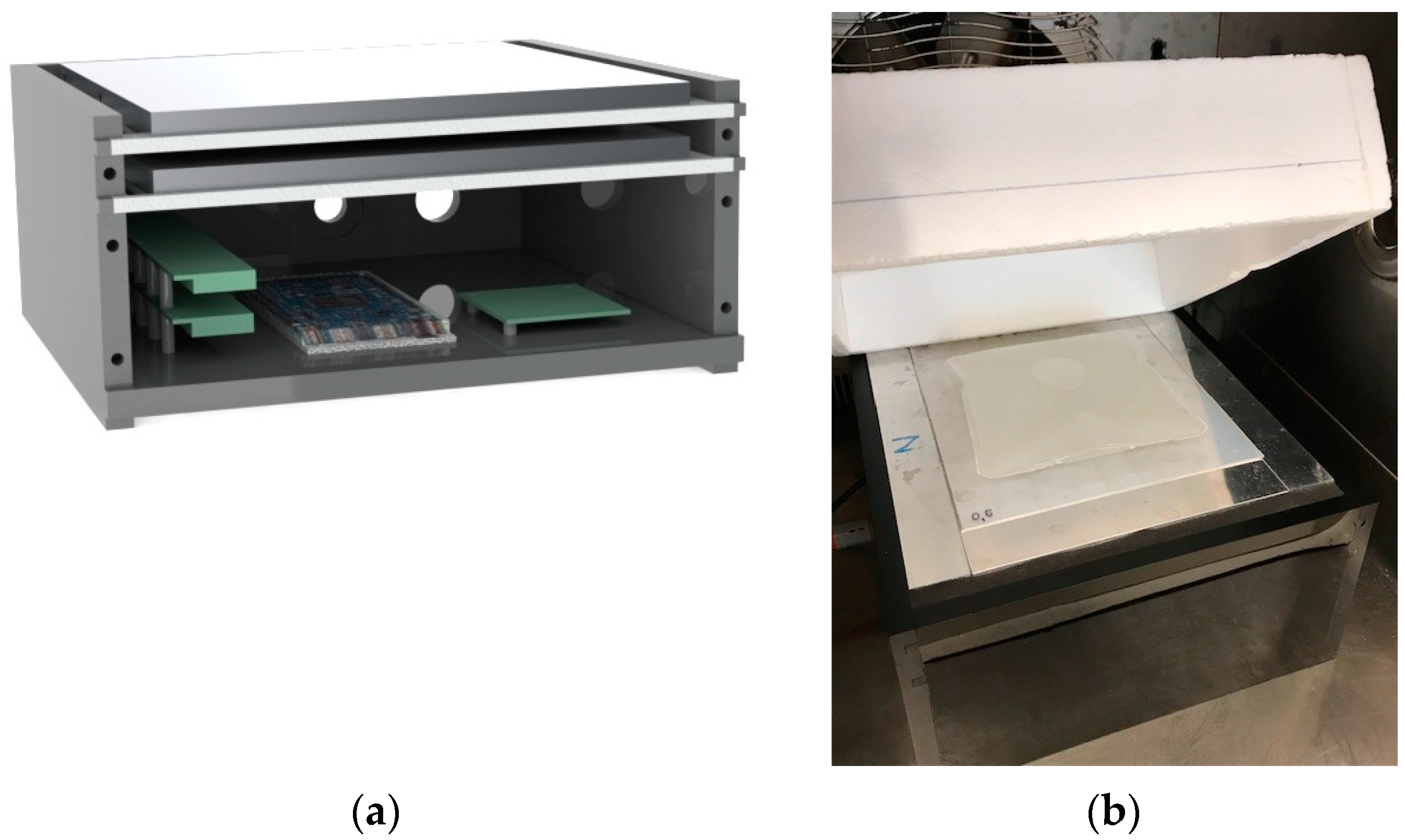
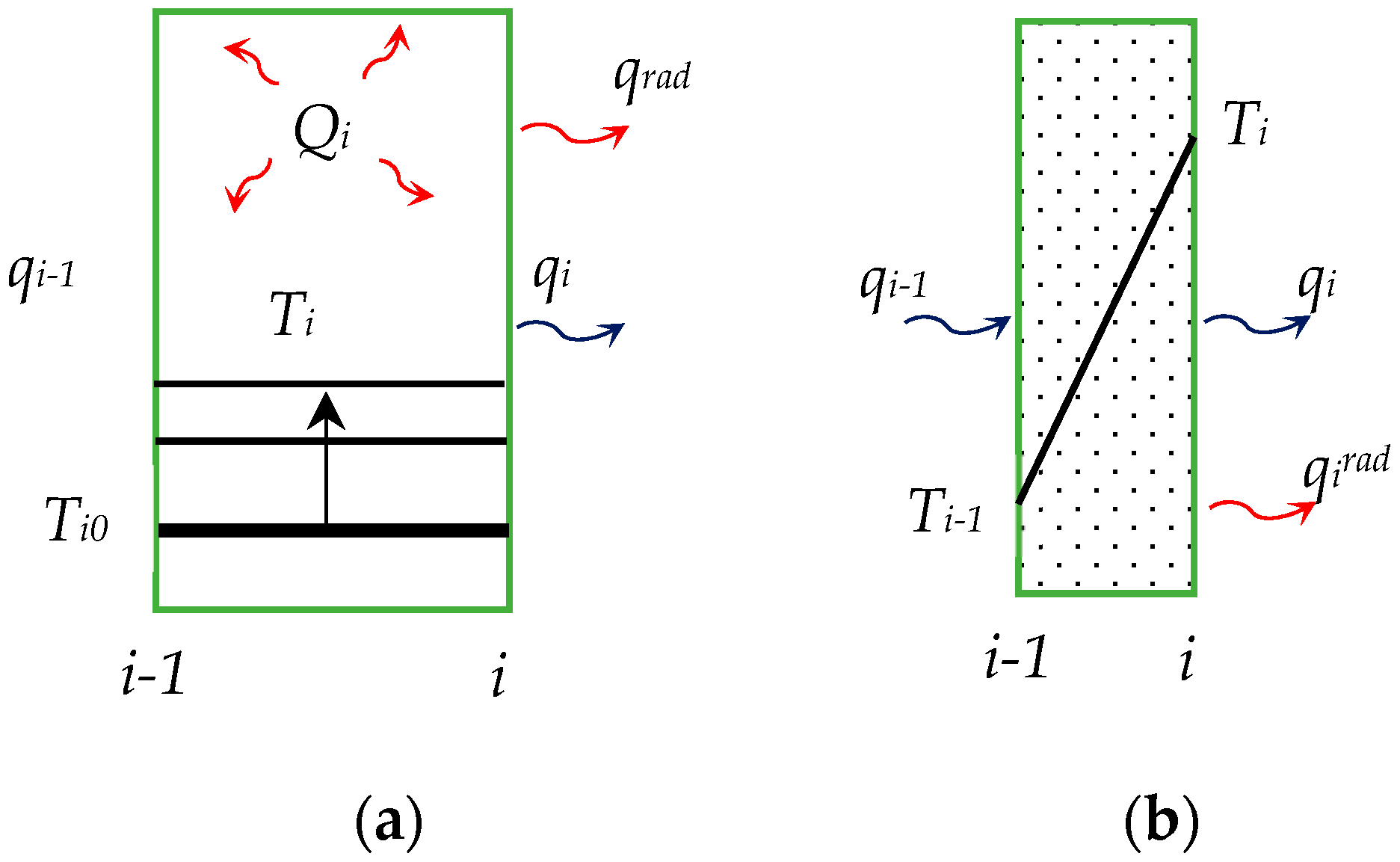
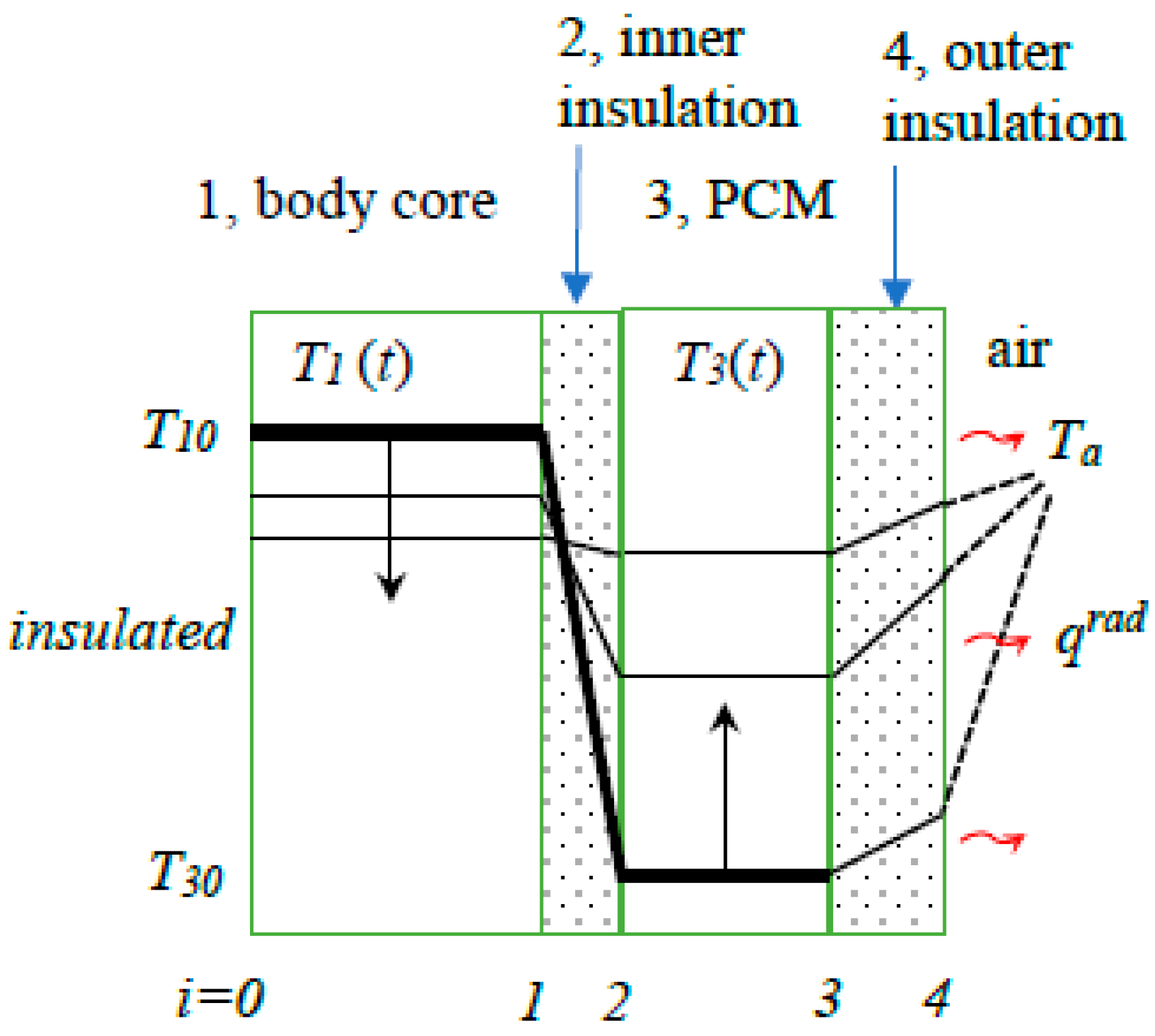
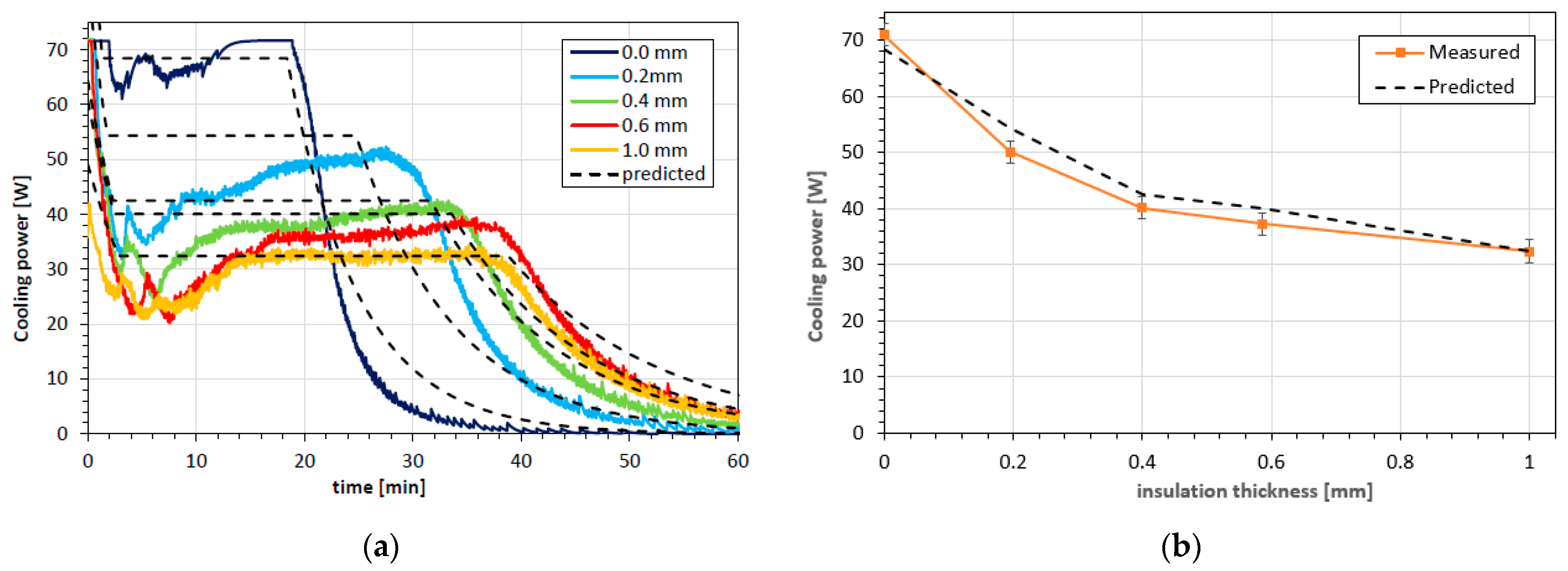


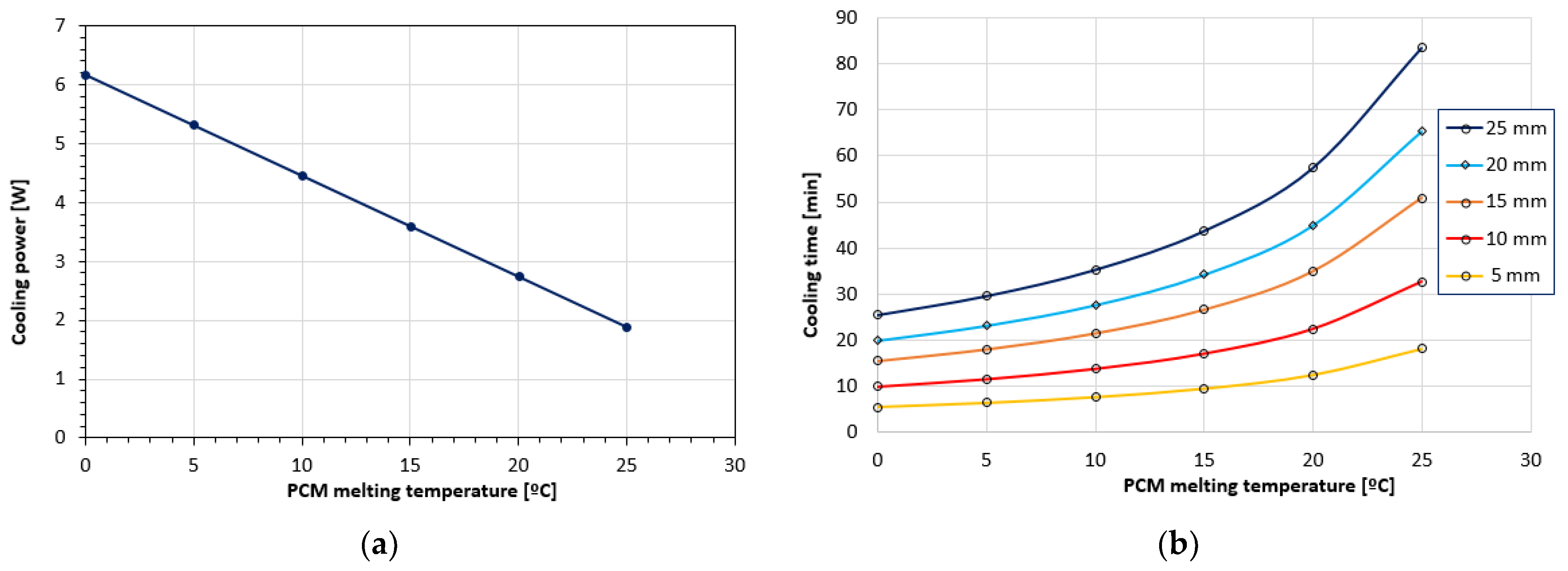
| Property | Layer 1 | Layer 2 | Layer 3 | Layer 4 | |||
|---|---|---|---|---|---|---|---|
| Body Core [14] | Skin [14] | Underwear | PCM Pocket | Air Gap | PCM, Na2SO4 | Outer Layer | |
| Thermal conductivity [Wm−1K−1] | 0.42 | 0.47 | 0.0614 | 0.0317 | 0.025 | 0.6 | 0.0592 |
| Specific heat [J/kg] | 3800 | - | 1340 | 1340 | - | 3600 | 1210 |
| Density [kg/m3] | 1085 | - | 317 | 392 | - | 500 | 607 |
| Thickness [mm] | 123 | 2.0 | 0.356 | 0.16 | 5 | 19.5 | 0.338 |
| Melting temperature [°C] | - | - | - | - | - | 21 | - |
| Melting enthalpy [kJ/kg] | - | - | - | - | - | 144 | - |
| Thermal resistance [m2KW−1] | - | 0.0048 | 0.0058 | 0.0050 | 0.20 | - | 0.0057 |
Publisher’s Note: MDPI stays neutral with regard to jurisdictional claims in published maps and institutional affiliations. |
© 2022 by the authors. Licensee MDPI, Basel, Switzerland. This article is an open access article distributed under the terms and conditions of the Creative Commons Attribution (CC BY) license (https://creativecommons.org/licenses/by/4.0/).
Share and Cite
Jansen, K.M.B.; Teunissen, L. Analytical Model for Thermoregulation of the Human Body in Contact with a Phase Change Material (PCM) Cooling Vest. Thermo 2022, 2, 232-249. https://doi.org/10.3390/thermo2030017
Jansen KMB, Teunissen L. Analytical Model for Thermoregulation of the Human Body in Contact with a Phase Change Material (PCM) Cooling Vest. Thermo. 2022; 2(3):232-249. https://doi.org/10.3390/thermo2030017
Chicago/Turabian StyleJansen, Kaspar M. B., and Lennart Teunissen. 2022. "Analytical Model for Thermoregulation of the Human Body in Contact with a Phase Change Material (PCM) Cooling Vest" Thermo 2, no. 3: 232-249. https://doi.org/10.3390/thermo2030017
APA StyleJansen, K. M. B., & Teunissen, L. (2022). Analytical Model for Thermoregulation of the Human Body in Contact with a Phase Change Material (PCM) Cooling Vest. Thermo, 2(3), 232-249. https://doi.org/10.3390/thermo2030017







